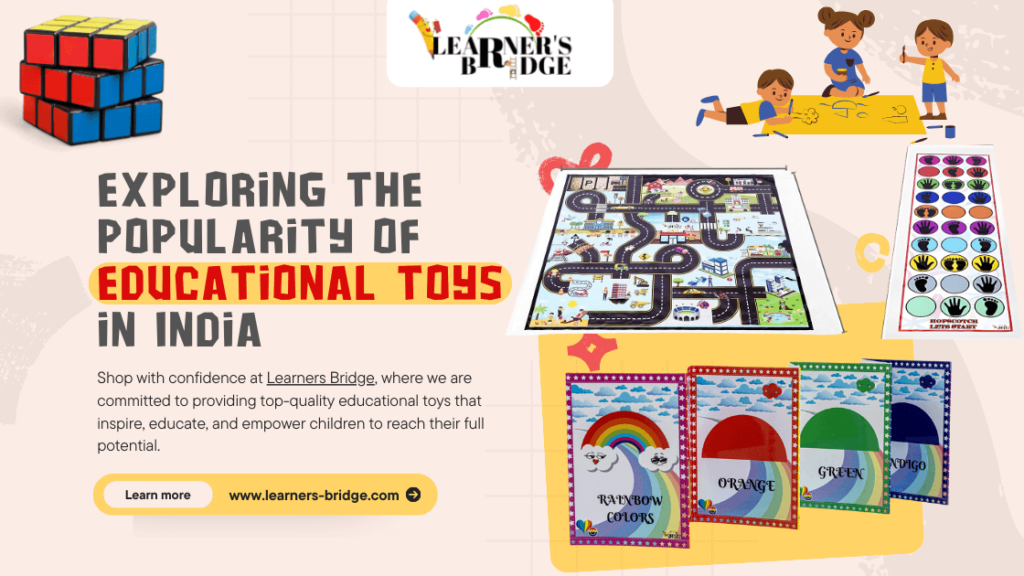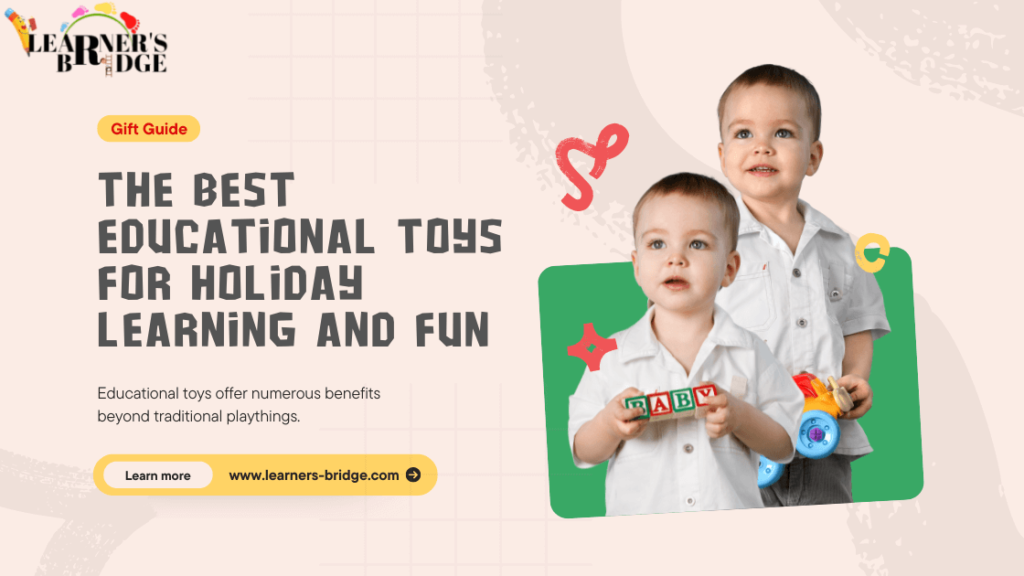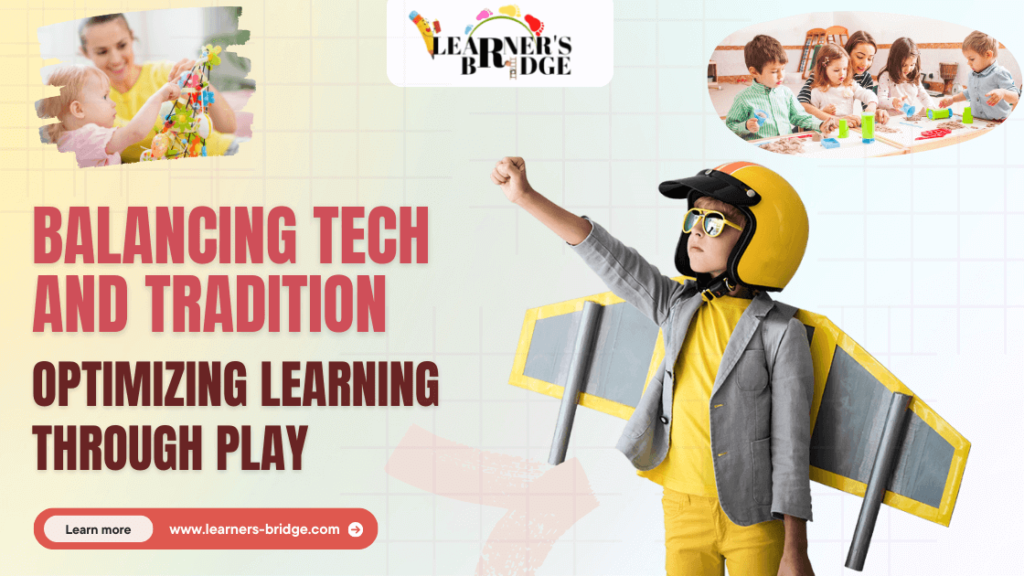
In India, educational toys are transforming learning experiences, enriching children’s growth. Delve into the reasons behind their surge in popularity, paving the way for holistic development and innovation.
Emphasis on Holistic Development:
In India, the notion of education extends far beyond academics; it encompasses the holistic development of a child. This cultural emphasis on nurturing every aspect of a child’s being has contributed significantly to the popularity of educational toys. Unlike traditional toys that merely entertain, educational toys are meticulously designed to engage children in activities that stimulate multiple facets of their development.
- Cognitive Development: Educational toys challenge children to think critically, solve problems, and make connections between concepts. Whether it’s a puzzle that encourages spatial reasoning or a building set that promotes logical thinking, these toys engage children’s minds in ways that foster intellectual growth. In a country where academic excellence is highly prized, parents recognize the value of such toys in laying a strong foundation for cognitive skills.
- Social Development: Through cooperative play with educational toys, children learn valuable social skills such as sharing, taking turns, and communicating effectively. Board games, role-playing sets, and collaborative building activities provide opportunities for children to interact with their peers, negotiate rules, and develop empathy and teamwork. In a society where interpersonal relationships are highly valued, these toys play a crucial role in shaping children into socially adept individuals.
- Emotional Development: Educational toys offer a safe space for children to explore and express their emotions. Dolls, puppets, and storytelling sets allow children to role-play various scenarios, express feelings, and develop empathy towards others. By engaging with these toys, children learn to identify and regulate their emotions, build resilience, and develop a positive self-image. In a culture that places a strong emphasis on emotional intelligence, these toys are invaluable tools for nurturing well-rounded individuals.
- Physical Development: In a world increasingly dominated by screens and sedentary activities, educational toys encourage physical activity and gross motor skills development. From outdoor play equipment like swings and slides to indoor toys like balls and balance boards, these toys promote active play and help children develop strength, coordination, and spatial awareness. Recognizing the importance of physical fitness in overall well-being, Indian parents are turning to educational toys to encourage their children to lead active lifestyles.
Complementing Traditional Education:
Traditional education systems often focus on imparting knowledge through structured lessons and standardized curricula. While essential, this approach may sometimes overlook individual learning styles and fail to fully engage students. Educational toys serve as invaluable supplements to traditional education by offering hands-on, interactive learning experiences that reinforce classroom teachings and ignite curiosity in young minds.
- Enhancing Understanding: Educational toys provide tangible representations of abstract concepts taught in classrooms. For instance, math manipulatives like counting blocks or fraction puzzles offer concrete visualizations that aid in understanding mathematical principles. Similarly, science kits allow students to conduct experiments and observe scientific phenomena firsthand, deepening their comprehension of scientific concepts. By bridging the gap between theory and practice, these toys enhance students’ understanding and retention of academic subjects.
- Promoting Critical Thinking: Unlike passive learning methods, educational toys encourage active participation and critical thinking. Construction sets like LEGO® or building blocks challenge students to plan, design, and problem-solve as they create structures and inventions. Puzzle games and logic-based toys require strategic thinking and analytical reasoning to solve challenges. By engaging in such activities, students develop essential skills like problem-solving, spatial reasoning, and logical thinking, which are vital for success in academics and beyond.
- Fostering Creativity: Traditional education often follows a structured curriculum that leaves little room for creativity and self-expression. Educational toys, on the other hand, encourage imaginative play and creative exploration. Art supplies, musical instruments, and storytelling sets allow students to express themselves freely and unleash their creativity. By nurturing creativity, these toys not only enrich students’ learning experiences but also foster innovation and entrepreneurial thinking, essential qualities in today’s rapidly changing world.
- Customizing Learning: Every student has unique strengths, weaknesses, and learning styles. Educational toys offer flexibility and adaptability, allowing educators to tailor learning experiences to individual students’ needs. Teachers can use a variety of toys and manipulatives to differentiate instruction, provide enrichment activities, or offer remedial support based on students’ abilities and interests. This personalized approach enhances student engagement and motivation, leading to more meaningful learning outcomes.
Encouraging Parental Involvement:
Parental involvement is widely recognized as a cornerstone of children’s academic success and overall well-being. Educational toys serve as catalysts for meaningful parent-child interactions, fostering bonds, and creating opportunities for shared learning experiences. By encouraging parental involvement, these toys empower parents to take an active role in their child’s education and development, thereby laying the foundation for lifelong learning.
- Bonding Through Play: Educational toys provide an avenue for parents to connect with their children in a fun and engaging way. Whether it’s building with blocks, solving puzzles, or engaging in imaginative play, these activities offer precious moments for quality bonding and shared laughter. Through play, parents can strengthen their relationship with their children, build trust, and create lasting memories that contribute to a strong family bond.
- Understanding and Supporting Development: Engaging with educational toys allows parents to gain valuable insights into their child’s interests, strengths, and areas for growth. Observing how their child interacts with different toys can provide clues about their learning preferences, cognitive abilities, and socio-emotional development. Armed with this knowledge, parents can offer targeted support, provide appropriate challenges, and facilitate their child’s growth and development in meaningful ways.
- Creating a Learning Environment at Home: Educational toys extend learning beyond the classroom walls and into the home environment. By incorporating these toys into daily routines, parents can create a supportive learning environment that nurtures curiosity and promotes continuous learning. Setting aside dedicated time for play, exploration, and discovery sends a powerful message to children about the importance of education and lifelong learning.
- Fostering Communication and Collaboration: Playing with educational toys encourages open communication and collaboration between parents and children. As they engage in cooperative play, parents and children learn to listen to each other’s ideas, negotiate rules, and work together towards common goals. These collaborative experiences promote the development of essential social skills such as empathy, cooperation, and conflict resolution, which are invaluable for navigating relationships both at home and in the wider world.
- Modeling Lifelong Learning: By actively participating in their child’s learning journey, parents model the value of lifelong learning and intellectual curiosity. When children see their parents engaging in educational activities, asking questions, and seeking out new knowledge, they are more likely to develop a positive attitude towards learning and become lifelong learners themselves.
Addressing Diverse Learning Styles:
Children possess unique learning styles and preferences, making it essential for educational approaches to be adaptable and inclusive. Educational toys cater to this diversity by offering a wide range of activities and experiences that accommodate various learning modalities. By addressing diverse learning styles, these toys ensure that every child has the opportunity to engage with learning in a way that resonates with them, fostering deeper understanding and retention of concepts.
- Visual Learners: Visual learners thrive on visual stimuli and benefit from seeing information presented in graphical or pictorial formats. Educational toys for visual learners often incorporate vibrant colors, engaging graphics, and visual aids that enhance comprehension. For example, flashcards, charts, and picture puzzles help visual learners grasp concepts through visual representation, making learning more accessible and enjoyable.
- Auditory Learners: Auditory learners prefer to process information through sound and benefit from listening to spoken instructions, lectures, or audio cues. Educational toys for auditory learners may include audio books, musical instruments, or interactive games with sound effects. These toys engage auditory learners by providing auditory feedback and reinforcement, facilitating comprehension and retention of information through auditory channels.
- Kinesthetic Learners: Kinesthetic learners learn best through hands-on, tactile experiences that involve movement and physical manipulation. Educational toys for kinesthetic learners encourage active participation and exploration, allowing children to learn by doing. Building blocks, clay, sensory bins, and STEM kits are examples of toys that engage kinesthetic learners, enabling them to touch, feel, and manipulate objects to understand concepts intuitively.
- Tactile Learners: Tactile learners learn through touch and physical interaction with materials. They benefit from sensory-rich experiences that stimulate their sense of touch and proprioception. Educational toys for tactile learners may include textured puzzles, sensory balls, sand trays, and manipulative toys with varying textures and shapes. These toys provide tactile feedback and sensory input, helping tactile learners process information more effectively through tactile exploration.
- Multimodal Learners: Many children exhibit a combination of learning styles, requiring multimodal approaches that incorporate multiple sensory modalities. Educational toys that offer multisensory experiences cater to these multimodal learners by engaging multiple senses simultaneously. For example, interactive electronic toys with visual, auditory, and tactile features provide a holistic learning experience that appeals to diverse learning preferences, accommodating the needs of a wide range of learners.
Fostering Creativity and Innovation:
Creativity and innovation are essential skills for success in the 21st century, driving progress, problem-solving, and entrepreneurial endeavors. Educational toys serve as catalysts for fostering creativity and innovation in children by providing open-ended, exploratory experiences that encourage experimentation, imagination, and divergent thinking. By nurturing these skills from a young age, educational toys empower children to become creative thinkers, problem solvers, and innovators who are equipped to tackle the challenges of tomorrow.
- Open-Ended Play Experiences: Educational toys offer opportunities for open-ended play, where there are no predetermined outcomes or rules, allowing children to explore, experiment, and create freely. Building blocks, art supplies, and construction kits are examples of toys that encourage open-ended play, empowering children to use their imagination to build, design, and invent without limitations. This freedom fosters creativity by allowing children to explore new ideas, take risks, and express themselves creatively.
- Encouraging Imagination: Imagination is the cornerstone of creativity, enabling children to envision possibilities, think outside the box, and generate innovative ideas. Educational toys stimulate children’s imaginations by providing props, settings, and characters for imaginative play. Dollhouses, play kitchens, and dress-up costumes allow children to role-play and create imaginary worlds, while storytelling sets and puppets inspire storytelling and narrative development. By engaging in imaginative play, children learn to think creatively, solve problems, and express themselves creatively.
- Promoting Problem-Solving Skills: Educational toys present challenges and puzzles that require children to think critically, analyze problems, and devise solutions. Puzzle games, logic games, and STEM kits encourage children to use their problem-solving skills to overcome obstacles and achieve goals. By engaging in these activities, children develop resilience, persistence, and resourcefulness, essential qualities for innovation and entrepreneurship. Through trial and error, children learn to approach problems from different angles, think creatively, and find innovative solutions.
- Exploring STEAM Concepts: Educational toys that integrate science, technology, engineering, art, and mathematics (STEAM) concepts provide hands-on experiences that promote creativity and innovation. Robotics kits, coding toys, and circuit building sets allow children to explore STEAM principles through experimentation and invention. These toys encourage children to apply their knowledge of STEAM concepts to real-world problems, fostering innovation and creativity in fields such as engineering, technology, and design.
- Celebrating Divergent Thinking: Educational toys celebrate divergent thinking, encouraging children to explore multiple perspectives, generate alternative solutions, and think creatively. Art supplies, musical instruments, and creative construction sets provide outlets for self-expression and innovation, allowing children to express their unique ideas and visions. By valuing divergent thinking, educational toys empower children to embrace their creativity, take risks, and pursue innovative ideas, laying the groundwork for future success in creative fields and entrepreneurial endeavors.
FAQs: Educational Toys from Learners Bridge
Educational toys, available at LearnersBridge, are carefully curated toys designed to stimulate learning and development in children. From infancy to adolescence, our toys cater to various age groups and developmental stages, fostering cognitive, social, emotional, and physical skills through engaging play experiences.
Educational toys from LearnersBridge offer numerous benefits for children, including enhancing cognitive abilities, promoting social skills, fostering creativity and innovation, encouraging problem-solving skills, and providing opportunities for hands-on learning experiences.
Children can start playing with educational toys from LearnersBridge as early as infancy. Our diverse collection includes toys suitable for every age and developmental stage, ensuring that children receive enriching learning experiences from the very beginning of their journey.
When selecting educational toys from LearnersBridge for your child, consider factors such as their age, interests, and developmental stage. Browse our extensive range of toys, which includes everything from sensory toys for babies to STEM kits for older children, and choose toys that align with your child’s unique needs and preferences.
You can purchase educational toys from Learners Bridge through our website, where you’ll find a comprehensive selection of high-quality toys designed to promote learning and development in children. Shop with confidence knowing that our toys are carefully curated to provide enriching experiences for children of all ages.
Conclusion:
In conclusion, educational toys offered by Learners Bridge play a pivotal role in nurturing children’s learning and development, catering to diverse needs and preferences. With a wide range of toys designed to stimulate cognitive, social, emotional, and physical skills, Learners Bridge empowers parents and educators to provide enriching experiences for children at every stage of their journey.
By embracing educational toys from LearnersBridge, parents can foster holistic development, encourage creativity and innovation, and promote lifelong learning in their children. Our carefully curated collection ensures that children receive engaging and age-appropriate toys that align with their interests and developmental milestones.
Whether it’s exploring STEAM concepts, honing problem-solving skills, or fostering social interactions, educational toys from LearnersBridge offer endless opportunities for growth and discovery. With each play session, children not only learn new concepts but also develop essential skills that will serve them well in the future.
Shop with confidence at Learners Bridge, where we are committed to providing top-quality educational toys that inspire, educate, and empower children to reach their full potential. Join us in unlocking the learning potential of every child through play, exploration, and discovery with our diverse range of educational toys.



